Finally, after decades of planning, construction, revolution and pandemic, the Grand Egyptian Museum is open. Well, not completely open, just "Open in trial mode" - sort of a beta testing phase.
I chronicled the long-running construction of the new Grand Egyptian Museum back in 2018. We became hopeful that the opening was near when we saw direction signs appear on the Ring Road a year ago.
We were aware that the museum was now open in "trial mode" before we arrived in January but thought that we would put off a visit on the hope that it would go into fully open mode before we returned home. We got encouragement to go visit when we visited our good friend, Jill, who described her visit - especially the "Tutankhamen Immersive Exhibition." (See description and brief preview here.)
Reservations are required, especially for the Immersive Exhibit, but it appeared that walk-ups were being admitted to the museum the day that we were there.
With our reservations/admission tickets in hand we drove to the museum
parking lot and were granted admission - well, after we were forced to return to the car and leave behind my cameras. "Photography is
permitted for personal use" - but not with a camera.*
I apologize for the photo quality. Next year I will bring a better quality mobile phone camera just for photos.
We took several pictures of the outside of the museum since we have been following the construction and admiring the appearance for so long.
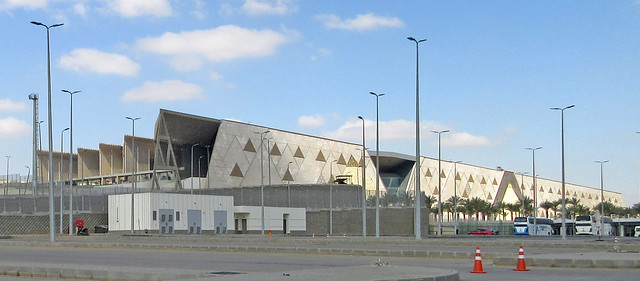

The ticket price for foreigners is 1200 Egyptian Pounds, about $25 apiece. We were able to skate by for half of that since we had our Egyptian residency cards. That is one of the benefits of that lengthy process described back at this post.

We had been particularly interested in seeing the obelisk outside. It was not among the many that once existed in ancient Heliopolis (see previous post) as it was brought here from Tanis, farther north in the Nile Delta where we had seen it back in 2019. Its companion also was moved from Tanis and now resides downtown in Tahrir Square.

The scale of this massive building is hard to appreciate until you approach the actual entrance and pass by the huge cartouches that decorate the surround.


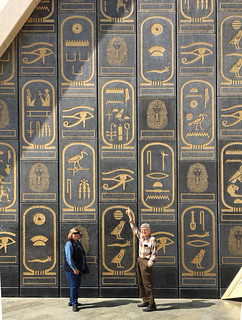
Once inside the building, the visitor feels the dominant presence of Ramses II represented by his 83-ton statue in the heart of the lobby.
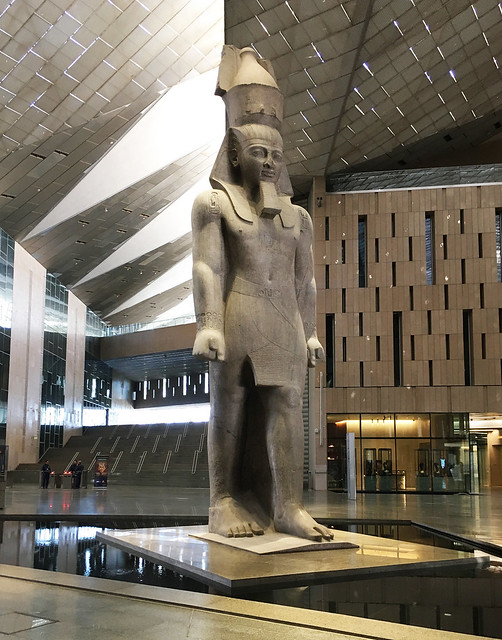
Poor Ramses. He was moved out here from the Cairo railway depot back in 2006 and has been patiently awaiting the opening of the GEM ever since. I never photographed him while he was at the station. We have visited his twin statue near Memphis/Dashour on numerous occasions, however, and have many photographs of him.

Our tickets specified admission to the 10:30 showing of the Immersive Exhibition. Like others, we followed the suggestion to arrive fifteen minutes early and joined the group near the theater entrance close to the grand staircase.
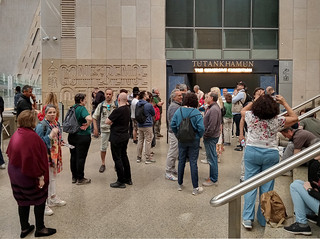

There is just a brief blurb about the development of the show. The mention on this poster of "square pixels," "black pixels" and high resolution numbers like 7920 was encouraging to this old tech guy. This was likely not going to be like the old standard definition projection TV at the heart of many U.S. National Park and monument shows.

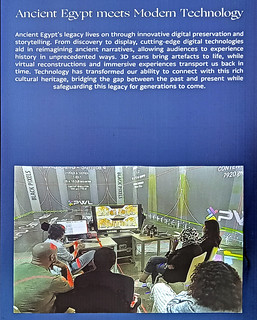
I was not disappointed. As the exhibition began, there were gasps and "ooh"s in several languages.
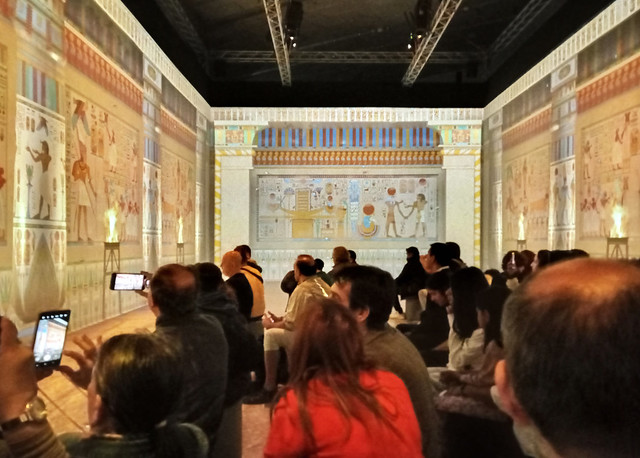
A bit of the simulated 3-D flavor of the projection video comes through in this photo showing a curved section of a tomb as it "rounds the corner" at the head of the room.

Part of the projected image also is displayed on the floor. I was a bit late in taking this next photo which would have shown the fish swimming up the Nile River beneath our feet. "Immersive" indeed!

Of course, as the room cleared, I took a couple of pictures of the projection units mounted on the ceiling. To describe it as a bit of a lash-up installation doesn't seem out of place. But the alignment of the projected images was absolutely seamless. I was impressed!


Following the Immersive Exhibition a museum guide led a quick half-hour tour of the open portion of the museum. We picked up a pair of headphones to hear the guide, although it wasn't necessary as there were only four of us in her tour group. Two Australians and we two Americans had a full English language tour to ourselves. Our guide normally led Chinese groups but was doing fill in work in English that day. She had excellent language skills and nicely handled questions.
We began at the bottom of the grand staircase, pausing to look at about half of the exhibits on the way up.


At the top of the staircase, there is a scale model of the museum showing its relationship to the Giza pyramids and there is a fine view of those pyramids from the window at the end of the building. In the future, there are supposed to be jitneys running between the museum and the pyramids, providing an improved experience for visitors.


The guided tour concluded at the top of the staircase and visitors were left on their own to descend and visit additional exhibits that had been pointed out as we climbed.


The Grand Museum provides a lot of space for exhibits that were difficult to house in the old museum downtown. The stairs provide a vantage point not possible otherwise and long expanses of space open up other possibilities.


This tip of Queen Hatshepsut's obelisk was attracting a lot of attention from visitors viewing it from a variety of angles.

Meanwhile, nearby, Linda was capturing an image of a liquid offering table.
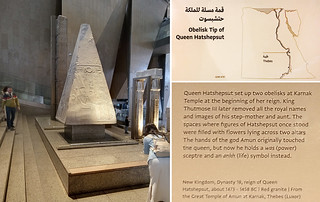

We had never encountered an offering table like this before. The suggestion that the depressions represent offerings from the different nomes (provinces) in Upper and Lower Egypt is intriguing.

As we reached the bottom of the staircase, I was delighted to discover that we were at the back side of the famed King's List found at nearby Saqqara. The front side has a modern up-to-date presentation of the king's names with their cartouche representations in order of their regency.


Looking around on the ground level, there was an array of pharonic statuary.
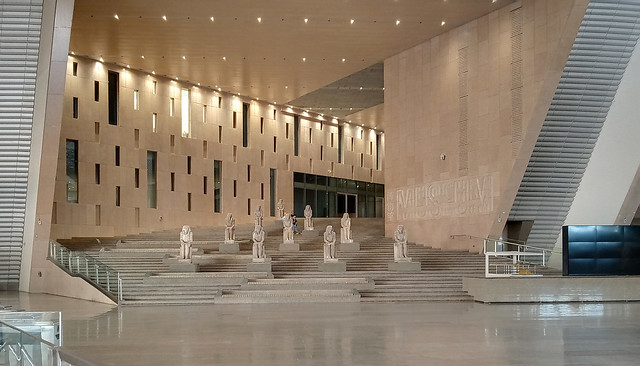
In the area of shops, we only found one open in addition to the museum shop selling souvenirs and books. The Atef Wassef jewelry store had quite a collection of silver, much of which we recognized as originating in the oasis town of Siwa that we visited last year. Many of their pieces are 95 years old.

Is it worth touring the Grand Egyptian Museum in its present "trial mode?" Absolutely. The Tutankhamen Immersive Exhibit is worth the price of admission just to admire the video display technology in use.
The small amount of museum space that is currently open on trial will occupy an interested person several hours. We spent three hours there and could have easily stayed much longer. I hope the full museum will finally be accessible by our next return in January.
* Cameras are not permitted but photography is. While I always protest that this makes no sense, the rationale seems pretty obvious. Too many tourists just don't know how to turn off the flash on their digital camera. Many have to be moved off of A(utomatic) and set to P(rogram). Others just don't have a clue that it can be done.





No comments:
Post a Comment